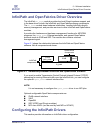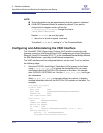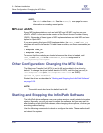
5 – Software Installation
OpenFabrics Drivers and Services Configuration and Startup
IB0056101-00 G 5-19
A
service[ 1]: 1000066a00000101
InfiniNIC.InfiniConSys.Data:01
.
.
.
2. Create the VNIC interfaces using the configuration file
/etc/infiniband/qlgc_vnic.cfg.
Look at the qlgcvnictools/qlgc_vnic.cfg sample to see how VNIC
configuration files are written. You can use this configuration file as the basis
for creating a configuration file by replacing the Destination Global Identifier
(DGID), IOCGUID, and IOCSTRING values with those of the EVIC/VEx
IOCs present on your fabric.
QLogic recommends using the DGID of the EVIC/VEx IOC, as it ensures the
quickest startup of the VNIC service. When DGID is specified, the IOCGUID
must also be specified. For more details, see the qlgc_vnic.cfg sample
file.
3. Edit the VirtualNIC configuration file,
/etc/infiniband/qlogic_vnic.cfg. For each IOC connection, add a
CREATE block to the file using the following format:
{CREATE; NAME="eioc2";
PRIMARY={IOCGUID=0x66A0130000105; INSTANCE=0; PORT=1; }
SECONDARY={IOCGUID=0x66A013000010C; INSTANCE=0; PORT=2;}
# }
NOTE:
A VIO hardware card can contain up to six IOCs (and therefore up to six
IOCGUIDs); one for each Ethernet port on the VIO hardware card. Each VIO
hardware card contains a unique set of IOCGUIDs: (e.g., IOC 1 maps to
Ethernet Port 1, IOC 2 maps to Ethernet Port 2, IOC 3 maps to Ethernet
Port 3, etc.).
NOTE:
The qlgc_vnic.cfg file is case and format sensitive.


















